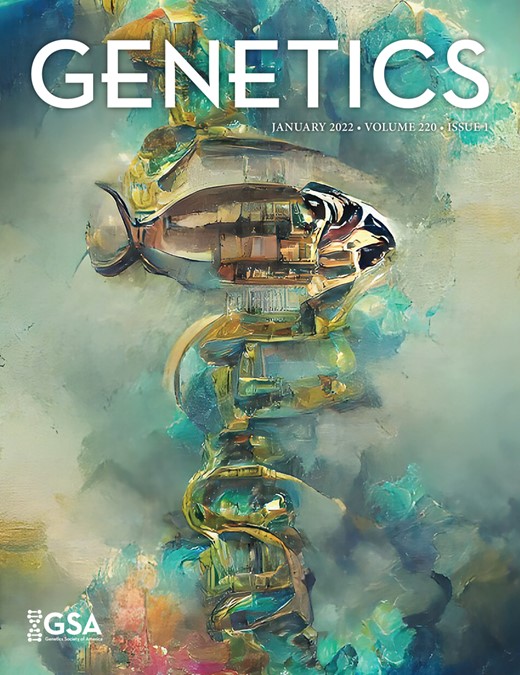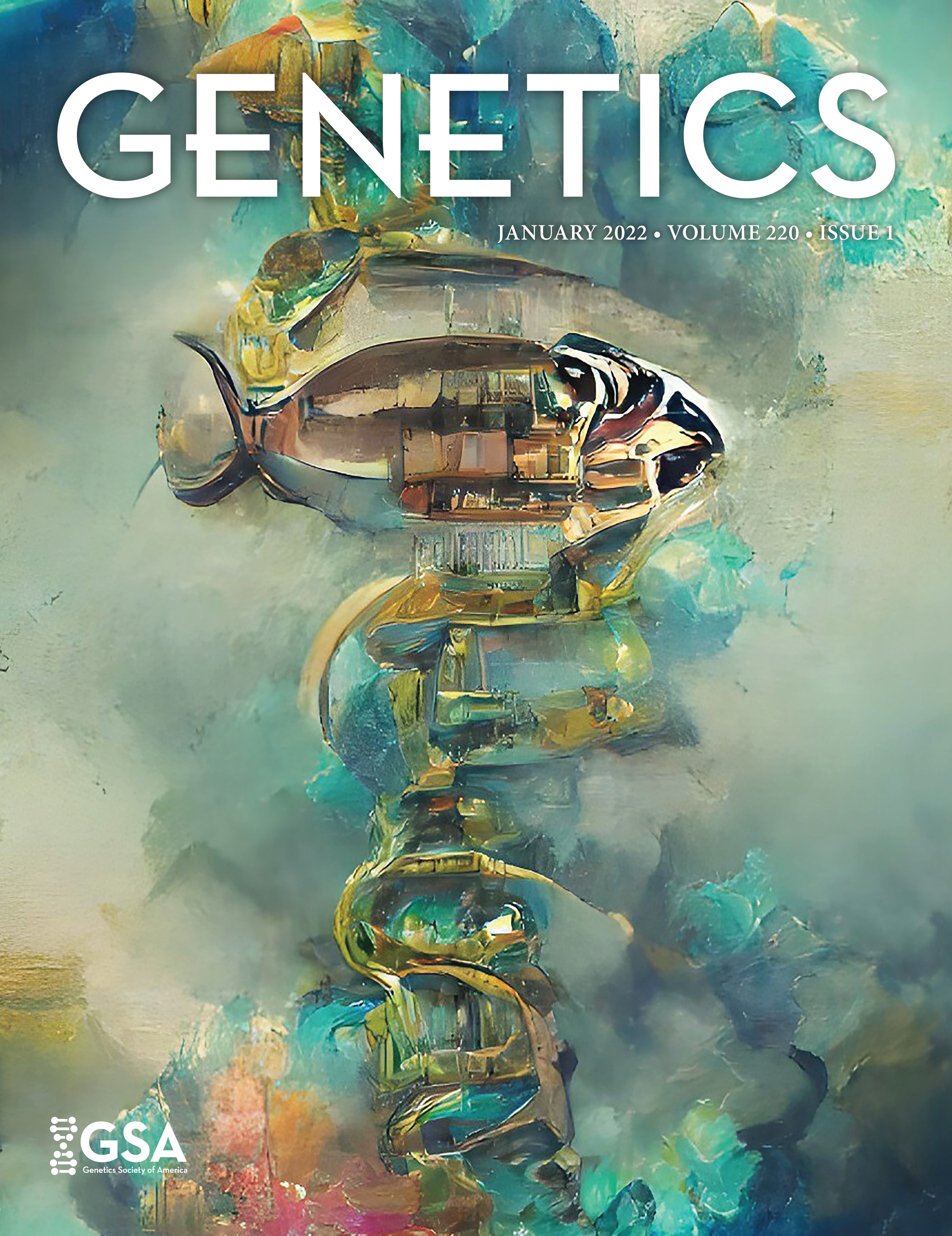
Cover image

Volume 220, Issue 1, January 2022
Perspectives
Unraveling the Gordian knot: genetics and the troubled road to effective therapeutics for Alzheimer’s disease
Review
Evolution of polygenic traits under global vs local adaptation
Wormbook
Evolution and Ecology
Natural genetic variation as a tool for discovery in Caenorhabditis nematodes
Communications
The length scale of multivalent interactions is evolutionarily conserved in fungal and vertebrate phase-separating proteins
Investigation
Cellular Genetics
The STRIPAK component SipC is involved in morphology and cell-fate determination in the nematode-trapping fungus Duddingtonia flagrans
Robust Cre recombinase activity in the biotrophic smut fungus Ustilago maydis enables efficient conditional null mutants in planta
The zinc cluster transcription factor Rha1 is a positive filamentation regulator in Candida albicans
Translational control of lipogenesis links protein synthesis and phosphoinositide signaling with nuclear division in Saccharomyces cerevisiae
Genetic analysis of Hsp90 function in Cryptococcus neoformans highlights key roles in stress tolerance and virulence
Heterogeneity in the transcriptional response of the human pathogen Aspergillus fumigatus to the antifungal agent caspofungin
Cecropins contribute to Drosophila host defense against a subset of fungal and Gram-negative bacterial infection
Experimental Technologies and Resources
A genetic toolkit for studying transposon control in the Drosophila melanogaster ovary
In eukaryotes, small RNA silencing pathways play fundamental roles in transposon control, which is of critical importance for genome stability. Drosophila is a leading study system for small RNA-guided transposon defense. Here, ElMaghraby, Tirian et al. present a set of genetic tools centered on transgenic RNA interference that will allow the dissection of the Piwi/piRNA pathway in the developing Drosophila ovary. This toolkit is particularly suited to study the intersection of piRNA biology and essential cellular processes.
Short homology-directed repair using optimized Cas9 in the pathogen Cryptococcus neoformans enables rapid gene deletion and tagging
Single nucleotide substitutions effectively block Cas9 and allow for scarless genome editing in Caenorhabditis elegans
Gene Expression
uS5/Rps2 residues at the 40S ribosome entry channel enhance initiation at suboptimal start codons in vivo
In eukaryotic protein synthesis, a preinitiation complex comprising the 40S ribosomal subunit, initiation factors, and initiator tRNAi scans the mRNA leader for an AUG codon in favorable context. The 40S protein uS5 (yeast Rps2) resides in the entry channel, but its role in start codon selection was unknown. Hinnebusch and Dong find that substituting uS5 residues near the entry channel increases discrimination against non-AUG codons and/or poor sequence context, both features of suboptimal start sites, implicating uS5/Rps2 in initiation accuracy.
Genetics of Complex Traits
Intermittent fasting and caloric restriction interact with genetics to shape physiological health in mice
Transmission distortion and genetic incompatibilities between alleles in a multigenerational mouse advanced intercross line
Multiple epistatic DNA variants in a single gene affect gene expression in trans
Genome and Systems Biology
Orthogonal CRISPR-Cas tools for genome editing, inhibition, and CRISPR recording in zebrafish embryos
The expanding Cas universe continues to provide new tools for manipulating genomes in animals. Takasugi, Wang, Truong et al. evaluate and report on a panel of orthogonal CRISPR and anti-CRISPR systems in zebrafish embryos. These tools will enable sophisticated genetic screens and improve other CRISPR tools, including lineage tracing.
Genome Integrity and Transmission
Blm helicase facilitates rapid replication of repetitive DNA sequences in early Drosophila development
Diet effects on mouse meiotic recombination: a warning for recombination studies
A motor independent requirement for dynein light chain in Caenorhabditis elegans meiotic synapsis
Molecular Genetics of Development
The entomopathogenic nematode Steinernema hermaphroditum is a self-fertilizing hermaphrodite and a genetically tractable system for the study of parasitic and mutualistic symbiosis
Entomopathogenic nematodes (EPNs) seek and invade insect hosts and release the mutually symbiotic pathogenic bacteria they carry. Together they kill the insect, and the bacteria act as a food source for the nematode. Cao, Schwartz, Tan, and Sternberg report development of the EPN Steinernema hermaphroditum, which is consistently hermaphroditic through self-fertilization, as an experimental genetic system for the study of symbiosis and parasitism. They describe the sex determination of this species and present efficient methods for in vitro culture, cryopreservation, and mutagenesis.
The F-box protein Bard (CG14317) targets the Smaug RNA-binding protein for destruction during the Drosophila maternal-to-zygotic transition
Degradation of the Smaug RNA-binding protein is essential for an orderly maternal-to-zygotic transition (MZT) and requires zygotic transcription. Cao et al. show that the F-box protein Bard is expressed in a narrow time window at the end of the MZT. Upon Bard expression, an SCF E3 ubiquitin ligase complex binds to Smaug, and Smaug is degraded. Loss of Bard results in failure to degrade Smaug, meaning Bard serves as a zygotic timer for Smaug clearance and an orderly MZT.
Wing hearts in four-winged Ultrabithorax-mutant flies—the role of Hox genes in wing heart specification
Insulin signaling and osmotic stress response regulate arousal and developmental progression of C. elegans at hatching
Evolutionarily conserved genetic interactions between nphp-4 and bbs-5 mutations exacerbate ciliopathy phenotypes
Neurogenetics & Behavior
The disease-associated proteins Drosophila Nab2 and Ataxin-2 interact with shared RNAs and coregulate neuronal morphology
Neuronal KGB-1 JNK MAPK signaling regulates the dauer developmental decision in response to environmental stress in Caenorhabditis elegans
A conserved behavioral role for a nematode interneuron neuropeptide receptor
Population and Evolutionary Genetics
Clonal evolution in serially passaged Cryptococcus neoformans × deneoformans hybrids reveals a heterogenous landscape of genomic change
The distribution of mutational effects on fitness in Caenorhabditis elegans inferred from standing genetic variation
Genome-wide association mapping of transcriptome variation in Mimulus guttatus indicates differing patterns of selection on cis- versus trans-acting mutations
Brown and Kelly perform a genome-wide association study on the transcriptome of yellow monkeyflower using previously sequenced inbred lines. They find a striking difference in the minor allele frequency spectrum of SNPs affecting gene expression in cis vs. in trans. The authors show that gene co-expression modules can predict fitness-related life-history phenotypes that experience fitness tradeoffs in field studies.
Muller’s ratchet of the Y chromosome with gene conversion
The relative impact of evolving pleiotropy and mutational correlation on trait divergence
Population biology of accessory gland-expressed de novo genes in Drosophila melanogaster
Statistical Genetics and Genomics
Properties and unbiased estimation of F- and D-statistics in samples containing related and inbred individuals
The quantitative genetics of the prevalence of infectious diseases: hidden genetic variation due to indirect genetic effects dominates heritable variation and response to selection
Bijma, Hulst, and De Jong develop a quantitative genetic theory of the host population for both R0 and the prevalence of infectious diseases, showing that most of the heritable variation for endemic prevalence is hidden due to Indirect Genetic Effects resulting from transmission dynamics of the infection. Consequently, genetic variation in the host population and response to selection for the prevalence are large and increase strongly when prevalence decreases. In contrast to classical theory, genetic selection can eradicate infectious diseases.


